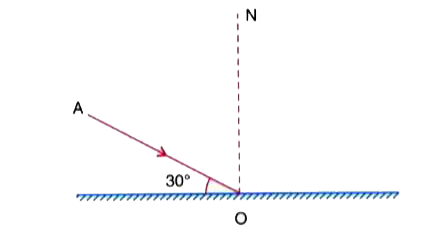A light ray is incident normally on a plane mirror.
What is its angle of incidence?
To solve the question, "A light ray is incident normally on a plane mirror. What is its angle of incidence?", we can follow these steps:
1. Understanding the Terms:
- The angle of incidence is defined as the angle between the incident ray and the normal (a line perpendicular to the surface of the mirror at the point of incidence).
2. Identifying the Situation:
- In this case, the light ray is incident "normally" on the plane mirror. "Normally" means that the light ray strikes the mirror at a right angle (90 degrees) to the surface.
3. Drawing the Diagram:
- Imagine a plane mirror. Draw a line representing the mirror surface.
- Draw a line (the incident ray) that strikes the mirror surface at a right angle (90 degrees).
- Draw a normal line perpendicular to the mirror surface at the point where the incident ray hits the mirror.
4. Measuring the Angle of Incidence:
- Since the incident ray is striking the mirror at a right angle, the angle between the incident ray and the normal line is 0 degrees.
5. Conclusion:
- Therefore, the angle of incidence when a light ray is incident normally on a plane mirror is 0 degrees.
Final Answer:
The angle of incidence is 0 degrees.
---
- The angle of incidence is defined as the angle between the incident ray and the normal (a line perpendicular to the surface of the mirror at the point of incidence).
- In this case, the light ray is incident "normally" on the plane mirror. "Normally" means that the light ray strikes the mirror at a right angle (90 degrees) to the surface.
- Imagine a plane mirror. Draw a line representing the mirror surface.
- Draw a line (the incident ray) that strikes the mirror surface at a right angle (90 degrees).
- Draw a normal line perpendicular to the mirror surface at the point where the incident ray hits the mirror.
- Since the incident ray is striking the mirror at a right angle, the angle between the incident ray and the normal line is 0 degrees.
- Therefore, the angle of incidence when a light ray is incident normally on a plane mirror is 0 degrees.
The angle of incidence is 0 degrees.
Topper's Solved these Questions
- BOOK - ICSECHAPTER - LIGHTEXERCISE - TOPIC 1 Reflections of Light (3 Marks Questions )19videos
LIGHT
- BOOK - ICSECHAPTER - LIGHTEXERCISE - TOPIC 1 Reflections of Light (4 Marks Questions )10videos
LIGHT
- BOOK - ICSECHAPTER - LAWS OF MOTIONEXERCISE - EXERCISE - 3(E) (Numericals)31videos
LAWS OF MOTION
- BOOK - ICSECHAPTER - MAGNETISM EXERCISE - EXERCISE-10(B) (Multiple Choice Type)2videos
MAGNETISM
Similar Questions
a light ray is incident normally on a plane mirror.
a. What is its angle of incidence?
b. What is the direction of reflected ray? Show it on a diagram.View SolutionA light ray is incident normally on a plane mirror.
What is the angle of incidence?View SolutionA ray of light falls normally on a plane mirror. What is the angle of incidence ?
View SolutionA light ray is incident normally on a plane mirror.
What is the direction of reflected ray? Show it on a diagram.View SolutionA light ray is incident normally on a plane mirror.
What is the direction of reflected ray? Show it on the diagram.View SolutionDraw the incident ray and the reflected ray. if a light ray is incident on a plane mirror with the angle of incidence 30∘.
View SolutionA ray of light is incident normally on a plane glass slab. What will be (i) the angle of refraction, and (ii) the angle of deviation for the ray ?
View SolutionA plane mirror lies face up, making an angle of 15∘ with the horizontal .A ray of light shines down vertically on the mirror .What is the angle of incidence? What will be the angle between the reflection ray and the horizontal?
View SolutionWhat will be the deviation produced when a ray of light is incident on a plane mirror at an angle of incidence 60∘?
View SolutionThe following diagram (Fig) shows an incident ray AO and the normal ON on a plane mirror. Find the angle of incidence and angle of reflection.
 View Solution
View Solution

